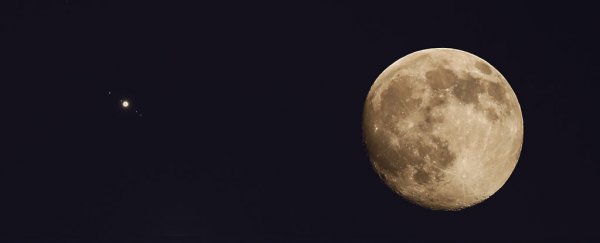Tomorrow morning, we're set to experience a penumbral lunar eclipse, where the full moon moves into Earth's shadow to ever-so-slightly darken the night sky. It's a cool event to look out for, but only those of you with the keenest eyesight will be able to see the darkening of the Moon - penumbral lunar eclipses are nowhere near as dramatic as total lunar eclipses.
But there's a reason for you to try - at the height of Wednesday's penumbral eclipse at 7:48am ET (6:48am CT, 10:48pm AEST), Jupiter will be much brighter than usual, and after having made its closest approach to the Moon on Monday, it will look like a big, bright star right next to the slightly dimmed full moon (so get your cameras ready).
It's expected that during this time, Jupiter's brightness will hit a -2.5 magnitude, and the full moon, even during the eclipse, will still be extremely bright at -12.4 magnitude.
To put those numbers in perspective, the Sun has an apparent magnitude of -27, the full moon -13, the brightest planet Venus measures -5, and Sirius, the brightest visible star in the night sky, is at -1.5.
If you're keen on watching it, people in the central and western United States will be in the best position to see the slightly darkened Moon, but parts of eastern Australia, New Zealand, Japan, central and eastern Asia, and the Pacific could also catch a glimpse of the phenomenon.
The eclipse is expected to last for 4 hours and 15 minutes on Wednesday morning (March 23), during which time at least part of the southern portion of the Moon will be have moved with the pale penumbra - the faint outer shadow of Earth - Joe Rao reports for Space.com.
"About that time, even a casual observer - if he or she is looking hard enough - should be able to note a slight diminution of light corresponding to a 'smudged' or 'soiled' appearance of the Moon's lower limb," he says.
So what exactly is a penumbral lunar eclipse? The name refers to when the Moon moves into the outer part of Earth's shadow, rather than the through all or part of the main shadow, which is when partial and total lunar eclipses occur.
Blaine Friedlander explains for The Washington Post:
"Earth produces two kinds of shadows: umbral and penumbral. As the Moon slides through the dark part of Earth's shadow (umbral), the Moon turns a copper-like red and that event can be quite pronounced. When the Moon moves through the outer shadow - the penumbral shadow - the eclipse features are less pronounced. In this case, it's the outer, outer shadow."
The next total lunar eclipse won't occur until 31 January 2018, and the next penumbral lunar eclipse is set for September this year, but the US won't be able to see that one, so set your alarms and wake up early to see just how much of this curious event you can make out.
Even if you just spot a super-bright Jupiter chilling alongside a full moon, that's a better start to the day than most!
